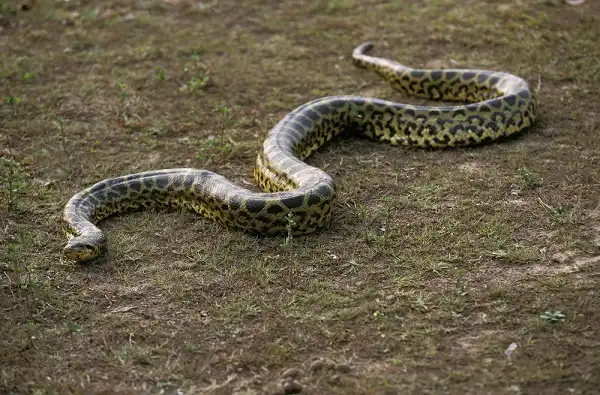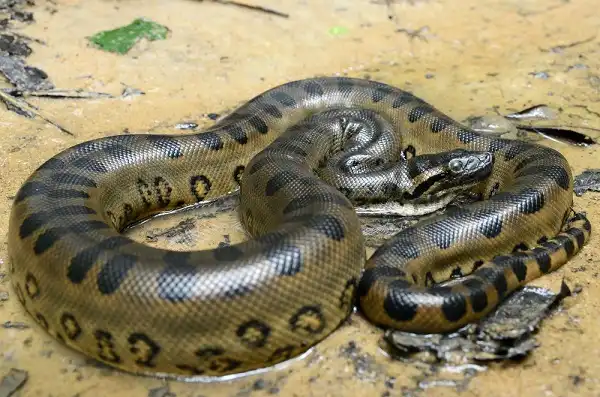Do you know about the anaconda? This massive snake is native to South America and can grow up to 30 feet in length. Anacondas are carnivorous animals, hunting their prey in the water. They have been known to attack and eat humans, making them one of the most feared creatures in the world. In this blog post, we will take a closer look at this amazing creature and find out more about its fascinating lifestyle.

Anaconda Description
The anaconda is a large and powerful species of snake native to South America. It is a member of the boa constrictor family. Anacondas have thick, heavy bodies with dark green or black scales that are marked with patterns of yellow or white spots. Their heads are broad and triangular in shape, with nostrils located near the top. Anacondas have incredible strength and agility – they can climb trees, swim at fast speeds underwater for several minutes at a time without coming up for air, and even scale walls or crossroads if need be! This adaptability has helped these animals survive despite threats from human activity such as hunting or habitat destruction. As fascinating creatures, anacondas are rightly feared by many but also admired by those who appreciate their impressive size and strength as well as the intricate details of their lives in the wild.
Anaconda Habitat
Anacondas are found in various habitats throughout South America, but they prefer warm, wet climates. They can be seen in swamps and marshes, lowland rainforests, and even slow-moving rivers. Anacondas are primarily aquatic animals, spending much of their time in the water hunting prey as well as seeking shelter from predators. In addition to still-water environments like lakes and ponds, adult anacondas can also be found in rapids and fast-moving streams. Although they occasionally move onto land to bask in the sun or hunt for food, most of an anaconda’s activities occur underwater. This is why it is important for their habitats to be rich in vegetation which provides them with plenty of cover from potential predators. Anacondas are also semi-arboreal creatures; meaning they will often climb trees and other structures in order to access better shelters or gain a higher vantage point when hunting. While on land or even when swimming close to shorelines, anacondas always take advantage of whatever cover is available including rocks, fallen logs, hollowed-out tree stumps, etc., making them difficult to spot unless you get close enough.

Anaconda Diet
Anacondas are carnivorous animals that feed mainly on fish, birds, small mammals, and other reptiles. They will hunt their prey using a combination of stealth tactics and brute force; gripping the prey with their powerful jaws before constricting them to suffocate them. Anacondas have also been known to attack and eat humans as well – making them one of the most feared creatures in the world. Although anacondas primarily feed on aquatic prey, they will occasionally venture onto land in search of food. Here, they will consume everything from ground-dwelling rodents to lizards and other small mammals. Anacondas will also scavenge for carcasses if needed, and may even eat plant matter in times of scarcity. Anacondas have highly efficient digestive systems that allow them to digest large meals quickly and easily – meaning they can survive long periods of time without needing more food. An adult anaconda can consume up to 40% of its body weight at once, though this is only possible when it has access to ample amounts of food sources. Anaconda diets vary between species; green anacondas typically prefer larger animals such as tapir or capybaras whereas yellow anacondas tend to feed more on birds, reptiles, and smaller mammals like mice or rats.
Anaconda Size
Anacondas are among the world’s largest snakes, and adults can reach lengths of up to 17 feet or more. Females tend to be larger than males, with an average adult female measuring around 10-12 feet in length and weighing up to 140 pounds. The biggest recorded anaconda measured more than 25 feet in length and weighed more than 550 pounds! Anacondas’ powerful bodies are equipped with sturdy scales that protect them from both predators and prey alike. The overall size of an anaconda will depend on its species; green anacondas are usually the biggest while yellow, Bolivian, and dark-spotted varieties tend to be slightly smaller in size.
Anaconda Lifespan
Anacondas typically have quite long lifespans, with some species living up to 20-25 years or even more in captivity. In the wild, however, their average lifespan is much shorter due to environmental factors such as predation from other animals and inadequate food sources. The longevity of an anaconda depends largely on its size; larger individuals tend to live longer due to increased thermogenesis capabilities which help them regulate their body temperature more efficiently. Their ability to survive cold temperatures also plays a role in their overall lifespan, as they are capable of hibernating during colder seasons and living off of stored energy reserves until conditions improve again.

Anaconda Behavior
Anacondas have fascinatingly complex behaviors that allow them to thrive in their respective environments. Their most remarkable ability is their impressive camouflage; they are able to blend in with the surrounding vegetation by employing a mix of patterned coloration and modifications such as flaps and crests on their scales. This helps them to effectively hide from potential predators, making it difficult for other animals to detect them. Anacondas also possess an impressive sense of smell, which they rely on to hunt for food and navigate through their environment. They use chemical receptors found in their tongue to locate prey at distances up to 10 meters away, making them some of the most effective predators out there. Anacondas can also detect vibrations produced by nearby animals, allowing them to determine where potential prey items are located before striking.
Anaconda Speed
Anacondas are known to be incredibly swift and agile creatures, with the ability to accelerate at impressive speeds both on land and in water. On land, they can reach up to 5mph in short bursts if the terrain is flat or slightly inclined. However, when faced with a steep slope or uphill conditions their speed may decrease due to their low body weight and slim build which does not offer much traction. In the water, anacondas are able to move more swiftly due to their remarkable swimming capabilities. They use a mixture of undulating body movements, similar to those found in sea snakes, combined with powerful tail strokes that propel them forward at astonishing speeds.
An adult anaconda is capable of reaching up to 8mph while swimming under optimal conditions, with some reports suggesting even higher maximum speeds for mature individuals who have had plenty of time to hone their aquatic skills. It’s important to note that anacondas do not maintain a constant speed while moving; rather they alternate between periods of acceleration and deceleration depending on the terrain or the proximity of potential prey items. This makes it difficult for observers to accurately measure their top speed as they can rapidly slow down and stop if necessary before continuing again after a brief rest period.

Anaconda Hunting
Anacondas are skilled hunters, capable of locating and catching prey from distances of up to 10 meters away. Due to their keen senses, they are able to detect vibrations and scents in the air that alert them when potential prey is nearby. This allows them to form a strategic plan before striking, resulting in a higher rate of successful hunts. When hunting, anacondas typically employ the ambush method – lying in wait for their target until it passes close by. Once within range, they will lunge forward, wrapping their bodies around the prey tightly. In addition to using their impressive strength during hunting, anacondas also take advantage of their stealthy movements and aquatic abilities. While on land, they use trees and rocks as cover, allowing them to conceal themselves until their prey is close enough for capture.
Conclusion
In conclusion, anacondas are one of nature’s most impressive predators – possessing both physical and mental capabilities that make them a formidable force within their habitats. Their powerful muscles combined with aquatic adaptations such as undulating body movements enable them to move with astonishing speed while on the hunt for prey. They also demonstrate great intelligence when it comes to strategizing and planning out hunts in advance which helps increase the success rate of each approach. Finally, their aggressive territorial behavior ensures that potential intruders or competitors know not to mess with these incredible creatures! With all of these impressive qualities, it is no wonder why anacondas have been able to thrive in their respective ecosystems throughout history.
Frequently Asked Question

